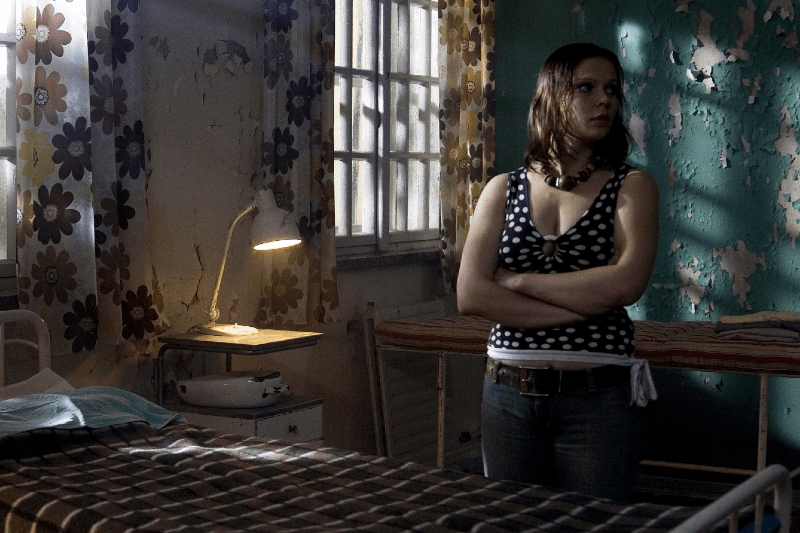Skeleton Crew is the meta millennial nasty you didn’t know you needed.
Sometimes, as a horror fan, it can feel like you’ve seen everything. So, it’s thrilling when you find something you haven’t even heard of before. That’s how I felt when I first heard about the Finnish film Skeleton Crew, directed by Tommi Lepola and Tero Molin. There are few reviews and even less critical analyses out there about this film, so a viewer can truly go into it without expectations. What you will find is the unexpected meta-nature of an under-the-radar torture porn film from 2009.
The aesthetic is spot-on for the 2000s – filthy, damp, green, and sickly. Skeleton Crew opens with a couple in a rainy car accident, seemingly in the middle of nowhere. They go to the only nearby building for help, which happens to be a creepy, run-down mental hospital. The acting is overdone, none of the characters’ choices make any sense, and it feels like the viewer was dropped into the middle of a story and missed the beginning.
But twenty minutes into the film, someone calls cut. It turns out that a film crew is shooting a movie about murders that took place in a hospital, and they are shooting in the exact location where the murders happened. The director explains aloud that his film will be “like a Saw or Hostel kind of thing.” While filming, the director finds tapes of the recorded murders. Skeleton Crew is a movie about making a movie based on snuff films.
Horror audiences are accustomed to meta-horror. Done well, meta-horror can be fun and subversive, taking tropes and turning them on their heads or boldly ignoring the tropes while acknowledging their existence at the same time. Films like Scream, Cabin in the Woods, and Tucker & Dale vs. Evil are well-loved and ripe for analysis because of how they dissect the slasher subgenre. Horror films that take a hard look at the genre reward fans for knowing the tropes and encourage fans to analyze what they love about horror.
But the torture porn subgenre had never gone meta before, at least not to the extent that Skeleton Crew does. Meta-slashers ask familiar in-world questions, wondering why virgins survive or why other characters refuse to call the police. The questions to explore in meta-torture porn are deeper: why are audiences fascinated with violence onscreen, and where is the limit for what’s acceptable in a fictional film? Skeleton Crew boldly explores those questions and invites the viewer to answer for themselves.
As a subgenre, torture porn is not the most popular among horror fans. It’s often not extreme enough for the fans of extreme cinema and, at the same time, too bleak and nasty for fans of more mainstream horror. Shoved into a corner and ignored, it is easy to see why torture porn hadn’t gotten meta before – people likely believed there wasn’t anything worth exploring.
In 2009, torture porn was wearing out its welcome, and its films were losing popularity as paranormal films were having a resurgence. Since torture porn was a subgenre that burned out fast and bright, 2009 was a good time to look at the past decade and ask, “What have we been doing here?” Where is the line between an entertaining horror film and something too sick to watch?
In Skeleton Crew, the director of the film-within-a-film becomes obsessed with watching the snuff films they found on set and forcing his staff to watch them. The rest of the crew are horrified and want to look away, but the director is coldly analyzing the filmmaking, not reacting to the violence. This is exactly how it can feel to be a fan of the torture porn subgenre, showing films to your friends who have very different tastes. What a viewer is willing to watch on screen is such a personal decision, and it’s often based on emotional reactions rather than a rational explanation.
For some viewers, anything fictional is OK on screen, but they draw the line at any real violence, including what you might see on the news. For others, maybe true-crime documentaries are their comfort watches, but a fictional horror film where a dog dies crosses the line. None of this needs to be justified or changed, but it’s always worth exploring what you are comfortable watching and why to better understand yourself and your tastes. Horror fans, in general, like to be scared and push their boundaries, and what scares you changes over the course of your life.
It’s worthwhile self-reflection to consider what scared you when you first started watching horror and what scares you now. What do you seek in your entertainment? While there is a huge and important difference between actual snuff films or other real-life violence and, for example, the Saw sequels, Skeleton Crew invites the viewer to consider why they watch what they watch for entertainment and why where they draw a line might be different from others.
The crew in Skeleton Crew, who are forced to watch the snuff films, don’t want to be implicated in the violence. They voice discomfort and threaten to quit, but they mostly stay in the room, and some avert their eyes. This represents how it can feel to be a horror fan – especially a fan of nasty horror films – when sometimes you don’t want to look away, but maybe you don’t want to watch either. A horror fan choosing to watch Skeleton Crew is the voyeur sitting on top of this pile of torture-all-the-way-down, watching a torture porn film about making a torture porn film based on snuff films.
Skeleton Crew takes meta-analysis to its logical conclusion, kicking apart the fourth wall until it barely exists anymore, including a post-credits scene that’s just the cherry on top of this multi-layered sundae. It’s worth the time of any horror fan who wants to further explore the torture porn subgenre.






